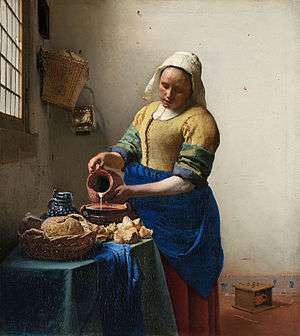Lead-tin-yellow
Lead-tin-yellow is a yellow pigment, of historical importance in oil painting,[1] also known as the "Yellow of the Old Masters".
History
Lead-tin-yellow occurred in two varieties. The first and more common one, today known as "Type I", was a lead stannate, an oxide of lead and tin with the formula Pb2SnO4. The second, "Type II", was a silicate of lead tin oxide with the formula Pb(Sn,Si)O3.[2] Lead-tin-yellow was produced by heating a powder mixture of lead oxide and tin oxide, in "Type II" combining the mixture with quartz. Its hue is a rather saturated yellow. The pigment is opaque and lightfast. It is also highly poisonous due to the lead component.
The origin of lead-tin-yellow can be dated back to at least the thirteenth century when Type II was applied in frescos, perhaps having been discovered as a by-product of crystal glass production. Until the eighteenth century Type I was the standard yellow used in oil painting. It was then almost completely replaced in use by Naples yellow. In the nineteenth century its existence had been forgotten and its application was only in 1941 rediscovered by the German scientist Richard Jakobi.[3] That it faded from collective memory has been explained by a confusion with massicot, the name of which was also applied to lead-tin-yellow. The term "lead-tin-yellow", a literal translation of German Blei-Zinn-Gelb, is therefore a modern designation, not the historical name of the pigment. In English it used to be called "general" after the Italian giallorino. After 1967, Hermann Kühn proved its general use in the traditional oil technique of earlier centuries, also distinguishing the Type I and Type II varieties.[2]
Lead-tin-yellow has been employed in the Renaissance[4] by painters such as Titian (Bacchus and Ariadne),[5] Bellini (The Feast of the Gods) and Raphael (Sistine Madonna), and during the Baroque period by Rembrandt (Belshazzar's Feast),[6] Vermeer (The Milkmaid),[7] and Velázquez (Apollo in the Forge of Vulcan).



References
- ↑ Lead-tin-yellow at ColourLex
- 1 2 Hermann Kühn, 1967, "Blei-Zinn-Gelb und seine Verwendung in der Malerei", Farbe und Lack 73: 938-949
- ↑ Richard Jacobi, 1941, "Über den in der Malerei verwendeten gelben Farbstoff der Alten Meister", Zeitschrift für Angewandte Chemie 54: 28–29
- ↑ Paintings sorted by historical period, ColourLex
- ↑ Lucas, A., Plesters, J. ‘Titian’s “Bacchus and Ariadne“‘. National Gallery Technical Bulletin Vol 2, pp 25–47
- ↑ Bomford, D. et al., Art in the making: Rembrandt, New edition, Yale University Press, 2006, pp.110-117
- ↑ Kühn, H., "A Study of the Pigments and the Grounds used by Jan Vermeer", Reports and Studies in the History of Art, National Gallery of Art (Washington, 1968)
Further reading
- Nicholas John Eastaugh, Lead tin yellow: its history, manufacture, colour and structure, University of London, 1988
See also
External links
- Lead-tin-yellow at ColourLex